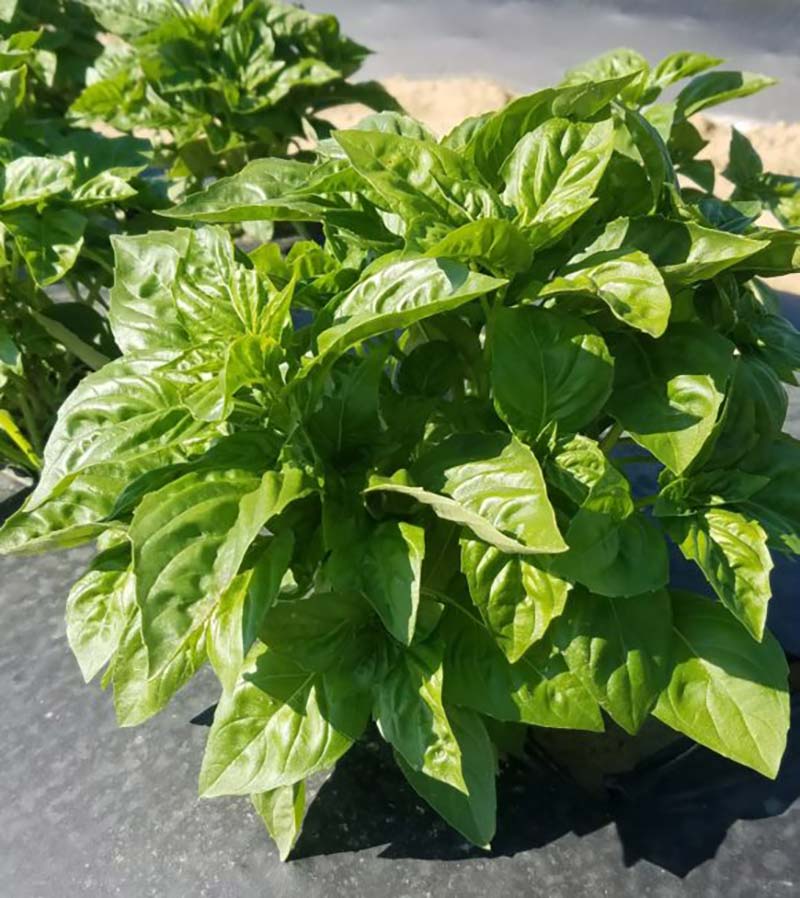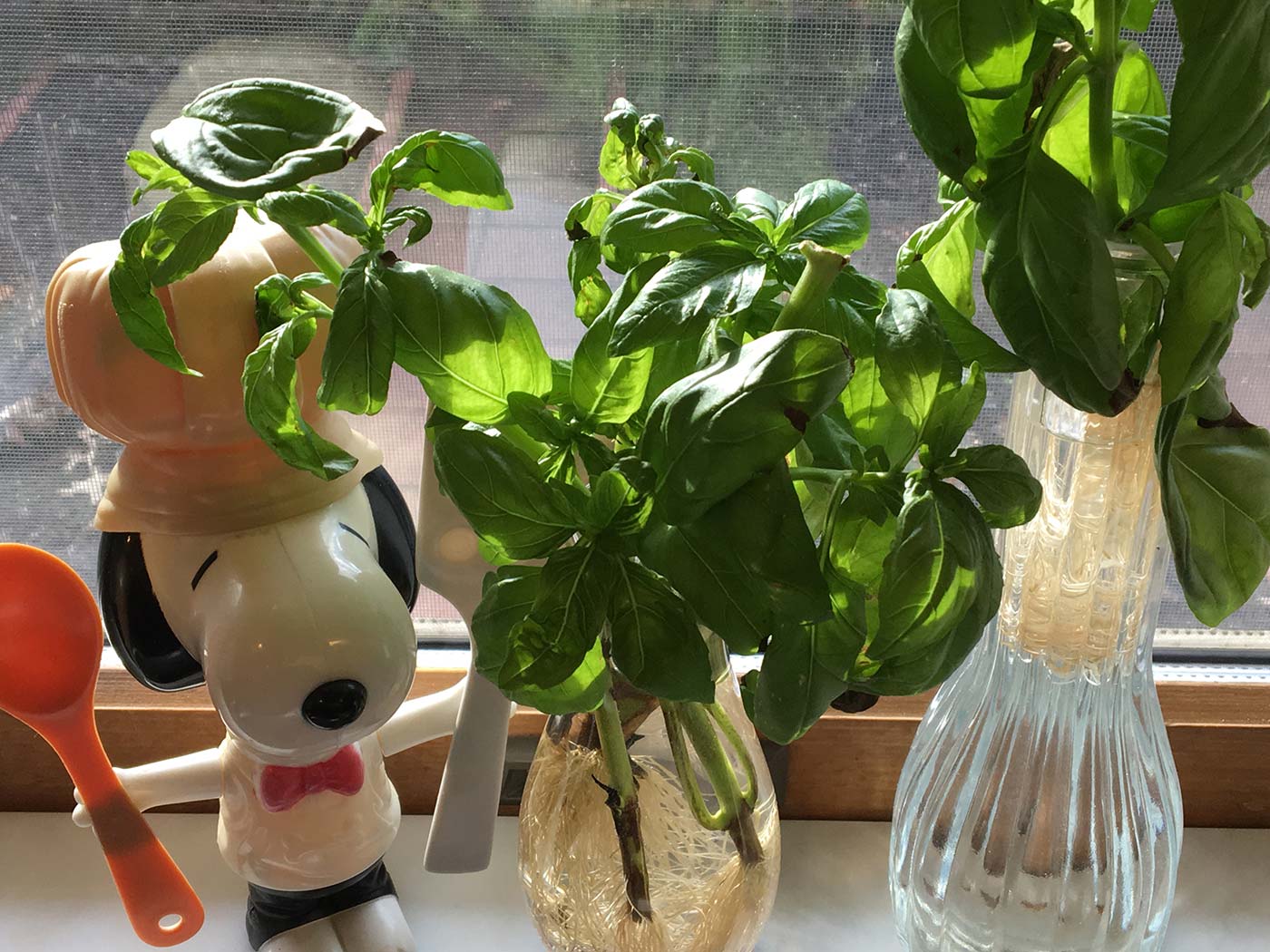Basil Bonanza
Editor’s note: The COVID-19 crisis has hit us all; we have been heartbroken, uplifted, unmoored. To help document the moment, Edible Jersey is sharing a few stories from our community. Here, Mary Ann Castronovo Fusco writes about the miracle of basil.
In unsettling times, it’s comforting to stumble upon an omen of hope. That’s how I felt last week when I casually brushed back the curtains above my kitchen sink to find that I’d hit the basil lottery: Two snippets of sweet basil that I’d set in water had grown a healthy mass of roots.
A couple of weeks earlier, I’d ventured out—appropriately masked and gloved— to my favorite local grocer. (Shout out to you, Cafasso’s Fairway Market in Fort Lee, for being well stocked throughout this ordeal!) Along with some other fresh produce, I picked up a sleeve of fresh basil for the tomato sauce I was making that day.
After plucking off the largest leaves for the sauce, I trimmed the bottoms of the stems, stuck them in a pair of vases filled with water, and left them on the counter. A few days later, I moved them onto the windowsill alongside a Chef Snoopy tchotchke—and then forgot all about them until the accidental reveal.
This wasn’t the first time I’d tried to root basil from a plant I’d bought at a grocery store. Previous attempts to follow the advice I’d been given to treat the basil like a bouquet of fresh flowers, however, had left me with a sad mass of droopy leaves. Why the success this time? Did Chef Snoopy have some kind of supernatural power?
Turns out, in snapping off the largest leaves before putting the stems in water, I’d unwittingly jump-started the rooting process. Reducing the leaf area cuts the amount of water needed to maintain them and channels the plant’s energy to giving the roots a boost, explains Jim Simon, distinguished professor of plant biology and director of the New Use Agriculture and Natural Plant Products Program at Rutgers University. He adds that keeping the basil in indirect sunlight on my countertop for a few days before moving it to the windowsill also helped by preventing evapotranspiration, or water loss.
This wasn’t the first time I’d tried to root basil from a plant I’d bought at a grocery store. Why the success this time?
Simon should know. For more than three decades, basil has been a primary focus of his research. At Rutgers, he oversees one of the world’s most extensive collections of basil from all over the world, more than 100 types. Most recently, he and his colleagues have been focused on developing sweet basil that’s resistant to downy mildew, which has devastated commercial production since 2010. First identified in Florida and possibly introduced via contaminated seeds, the disease looks like gray-black soot between the veins on the underside of the leaves, and causes them to yellow.
Simon’s research team, which includes Andy Wyenandt, an associate extension specialist in vegetable pathology at the Rutgers Agricultural Research and Extension Center near Bridgeton, has developed four varieties of downy mildew resistant (DMR) basil: Rutgers Obsession DMR, Rutgers Devotion DRM, Rutgers Passion DMR, and Rutgers Thunderstruck DMR. “This will be the second full season that these types will be available. It’s a Jersey-created line, created with the participation of Jersey growers,” says Simon. “All was done using traditional but innovative plant breeding—none are GMO. And there are now organically certified lines available.” Seeds are available from https://www.vdfspecialtyseeds.com/.
According to Christian legend, St. Helena found the remains of Christ’s cross beneath a fragrant patch of basil. Its name comes from the Greek basilikón, “royal.” A member of the mint family, basil has been used in cooking since ancient times, when it was also used as a medicinal agent. The aromatic herb contains polyphenols, which have antioxidant properties, and essential oils that been shown to be anti-microbial. Purple varieties of basil are particularly rich in anthocyanins, powerful antioxidants. That said, we primarily value the flavor that basil lends to salads, sauces, and other food.
“You can get all types of tastes from all types of basil,” says Simon. “And the smell is sweet, floral, and relaxing, like lavender, which is in the same family.”
Once I get around to turning the soil in the vegetable beds on the other side of my kitchen window, I’ll put my little plants in the ground, where they’ll have more room to grow— and provide me with the added comfort of knowing I won’t have to venture far for my basil in the weeks to come.

Photo courtesy of Andy Wyenandt/Rutgers University-New Brunswick.
BASIL DOS AND DON'TS:
Never refrigerate basil, or its vibrant leaves will blacken. Researchers are still trying to develop cold-resistant varieties to withstand refrigeration in transit and at home, as well as to extend the local growing season.
To prevent wilting, take off the largest leaves, snip the stems, and place the basil in a glass of water. Alternatively, wrap the leaves in a damp paper towel and leave it at room temperature. The fresher the basil, the longer it will keep.
To prevent darkening when cutting large quantities of basil into thin strips, rub the leaves with a few drops of olive oil before stacking and slicing them.
Don’t waste the stems. Smack them with the back of a knife to release the flavor and add them to soups and sauces.
When growing your own, remember that basil needs a lot of sun. At nurseries and garden centers, carefully inspect the undersides of basil seedlings for signs of downy mildew before buying.







